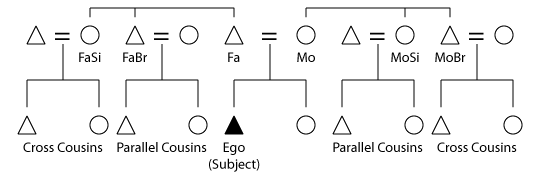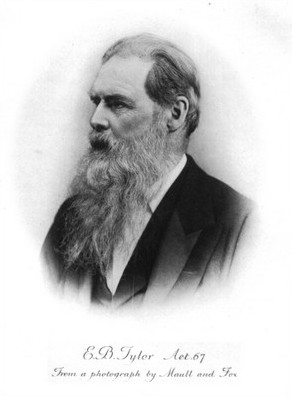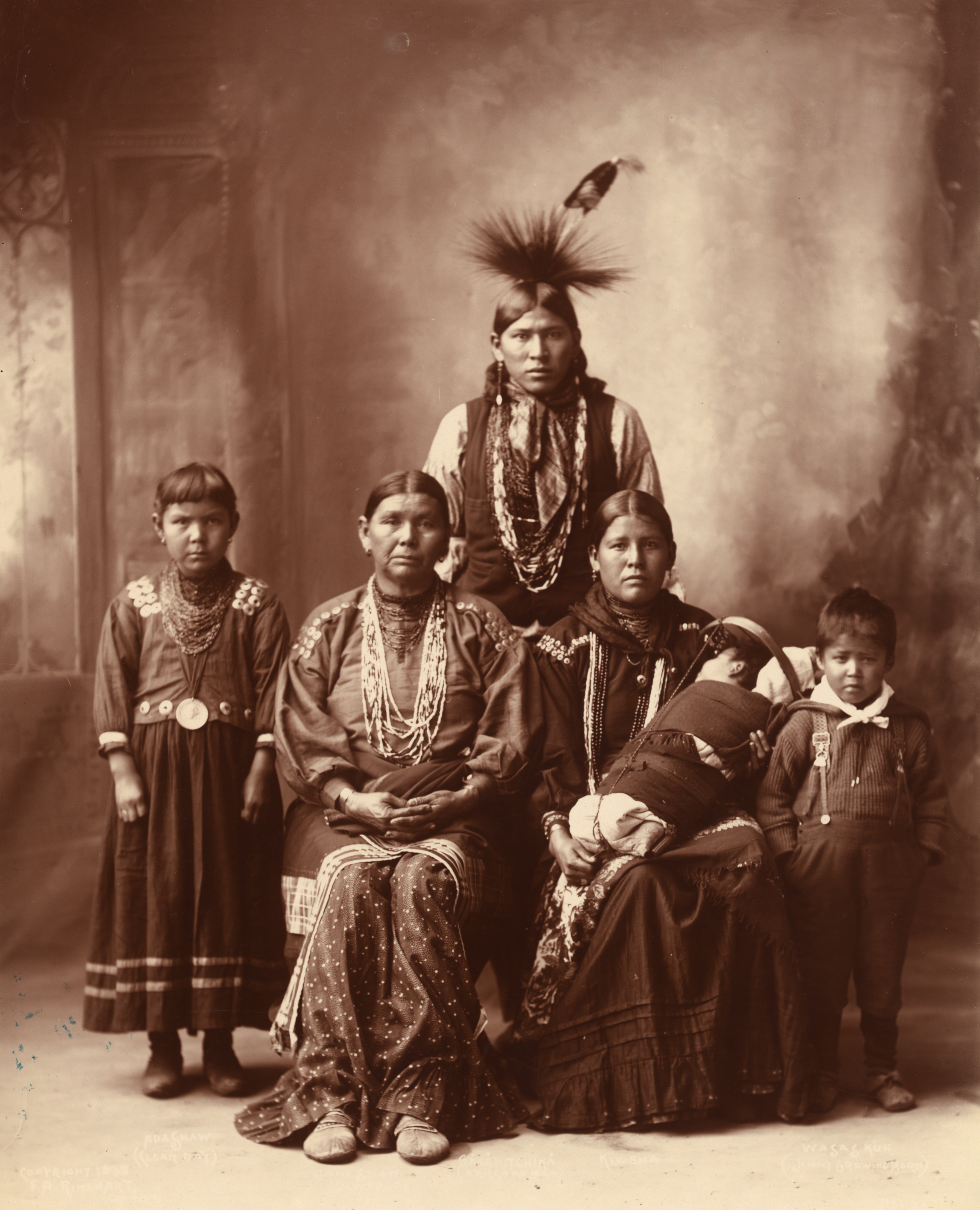|
Parallel-cousin
In discussing consanguineal kinship in anthropology, a parallel cousin or ortho-cousin is a cousin from a parent's same-sex sibling, while a cross-cousin is from a parent's opposite-sex sibling. Thus, a parallel cousin is the child of the father's brother (paternal uncle's child) or of the mother's sister (maternal aunt's child), while a cross-cousin is the child of the mother's brother (maternal uncle's child) or of the father's sister (paternal aunt's child). Where there are unilineal descent groups in a society (i.e. matrilineal and/or patrilineal), one's parallel cousins on one or both sides will belong to one's own descent group, while cross-cousins will not (assuming descent group exogamy). Role The role of cross-cousins is especially important in some cultures. For example, marriage is promoted between them in the Iroquois system. Parallel cousins are occasionally the subject of promoted marriage, such as the preferential marriage of a male to his father's brother's da ... [...More Info...] [...Related Items...] OR: [Wikipedia] [Google] [Baidu] [Amazon] |
Cousin Marriage
A cousin marriage is a marriage where the spouses are cousins (i.e. people with common grandparents or people who share other fairly recent ancestors). The practice was common in earlier times and continues to be common in some societies today. In some jurisdictions such marriages are prohibited due to concerns about inbreeding. Worldwide, more than 10% of marriages are between first or second cousins. Cousin marriage is an important topic in anthropology and alliance theory. In some cultures and communities, cousin marriages are considered ideal and are actively encouraged and expected; in others, they are seen as incestuous and are subject to social stigma and taboo. Other societies may take a neutral view of the practice, neither encouraging nor condemning it, though it is usually not considered the norm. Cousin marriage was historically practiced by indigenous cultures in Indigenous Australians, Australia, Indigenous peoples of the Americas#North America, North America, Indig ... [...More Info...] [...Related Items...] OR: [Wikipedia] [Google] [Baidu] [Amazon] |
Andrey Korotayev
Andrey Vitalievich Korotayev (; born 17 February 1961) is a Russian anthropology, anthropologist, economic history, economic historian, comparative politics, comparative political scientist, demography, demographer and sociology, sociologist, with major contributions to world-systems theory, cross-cultural studies, Near Eastern history, Big History, and mathematical modelling of social and Macroeconomics, economic macrodynamics. He is currently the Director of the Centre for Stability and Risk Analysis at the Higher School of Economics, HSE University in Moscow, and a Senior Research Professor at the Center for Big History and System Forecasting of the Institute of Oriental Studies of the Russian Academy of Sciences, Institute of Oriental Studies as well as in the Institute for African Studies of the Russian Academy of Sciences. In addition, he is a senior research professor of the International Laboratory on Political Demography and Social Macrodynamics (PDSM) of the Russia ... [...More Info...] [...Related Items...] OR: [Wikipedia] [Google] [Baidu] [Amazon] |
Incest
Incest ( ) is sexual intercourse, sex between kinship, close relatives, for example a brother, sister, or parent. This typically includes sexual activity between people in consanguinity (blood relations), and sometimes those related by lineage (anthropology), lineage. It is condemned and considered immoral in many societies. It can lead to an increased risk of genetic disorders in children in case of pregnancy from incestuous sex. The incest taboo is one of the most widespread of all cultural taboos, both in present and in past societies. Most modern societies have laws regarding incest or social restrictions on closely consanguineous marriages. In societies where it is illegal, consensual adult incest is seen by some as a victimless crime. Some cultures extend the incest taboo to relatives with no consanguinity, such as Milk kinship, milk-siblings, stepsiblings, and adoptive siblings, albeit sometimes with less intensity. Third-degree relatives (such as half-aunt, half-nephew ... [...More Info...] [...Related Items...] OR: [Wikipedia] [Google] [Baidu] [Amazon] |
Consanguinity
Consanguinity (from Latin '':wikt: consanguinitas, consanguinitas'' 'blood relationship') is the characteristic of having a kinship with a relative who is descended from a common ancestor. Many jurisdictions have laws prohibiting people who are closely related by blood from Consanguine marriage, marrying or having sexual relations with each other. The degree of relationship, degree of consanguinity that gives rise to this prohibition varies from place to place. On the other hand, around 20% of the global population lives in areas where some consanguinous marriages are preferred. The degree of relationships are also used to determine heirs of an estate according to statutes that govern intestacy, intestate succession, which also vary from jurisdiction to jurisdiction. In some communities and time periods, cousin marriage is allowed or even encouraged; in others, it is taboo, and considered to be incest. The degree of relative consanguinity can be illustrated with a ''consanguinity ... [...More Info...] [...Related Items...] OR: [Wikipedia] [Google] [Baidu] [Amazon] |
Eskimo Kinship
Eskimo kinship (or Inuit kinship in Canada) is a category of kinship used to define family organization in anthropology. Identified by Lewis H. Morgan in his 1871 work ''Systems of Consanguinity and Affinity of the Human Family'', the Eskimo system was one of six major kinship systems (Eskimo, Hawaiian kinship, Hawaiian, Iroquois kinship, Iroquois, Crow kinship, Crow, Omaha kinship, Omaha, and Sudanese kinship, Sudanese). The system of English-language kinship terms falls into the Eskimo type. Joint family The Extended family, joint family system places no distinction between Patrilineality, patrilineal and Matrilineality, matrilineal relatives; instead, it focuses on differences in kinship distance (the closer the relative is, the more distinctions are made). The system emphasizes the nuclear family, identifying directly only the mother, father, brother, and sister. All other relatives are grouped together into categories. It uses both Classificatory kinship, classificatory and ... [...More Info...] [...Related Items...] OR: [Wikipedia] [Google] [Baidu] [Amazon] |
Palomar College
Palomar College is a public community college in San Diego County, California. The main campus is in San Marcos and three centers and four education sites are located elsewhere throughout north San Diego County. Academics Palomar College offers 250 associate's degrees and certificate programs, and also offers programs for students wishing to transfer to many different four-year universities, including institutions in the University of California and California State University systems. These programs are organized into five academic divisions: *Arts, Media, Business Administration *Career, Technical and Extended Education *Languages and Literature *Mathematics and The Natural and Health Sciences *Social and Behavioral Sciences In addition, Palomar College and other local adult schools in North County work collaboratively to leverage services and resources to better serve adult education students in the areas of Adult Basic Education, ESL, GED, HISET, high school diploma, and ... [...More Info...] [...Related Items...] OR: [Wikipedia] [Google] [Baidu] [Amazon] |
Mahram
In Islam, a () is a family member with whom marriage would be considered permanently unlawful (''haram''). A woman does not need to wear hijab around her mahram or spouse, and an adult male mahram or husband may escort a woman on a journey, although an escort may not be obligatory. Overview People with whom marriage is prohibited * permanent or blood ''mahrams'' include: ** all direct ancestors ** all direct descendants ** siblings ** siblings of parents, grandparents, and further antecedents ** children and further descendants of siblings * in-law ''mahrams'' with whom one becomes ''mahram'' by marrying someone: ** all the ancestors of one's spouse ** all the descendants of one's spouse ** all who marry a direct ancestor ** all who marry a direct descendant (A woman may marry her stepfather, but only if the stepfather has not consummated his marriage to her mother.) * ''Rada'' or "milk-suckling ''mahrams''" with whom one becomes ''mahram'' because of being nursed by the s ... [...More Info...] [...Related Items...] OR: [Wikipedia] [Google] [Baidu] [Amazon] |
List Of Coupled Cousins
This is a list of notable individuals who have been romantically or maritally coupled with a full first cousin. Worldwide, more than 10% of marriages are between first or second cousins. Cousin marriage is an important subject in sociology, anthropology, and alliance theory. Notable people A * Edwin Abbott (1808–1882), English educator, and his first cousin, Jane Abbott (1806–1882) * Samuel Abravanel (1473–1551), Sephardic-Italian financier, and his first cousin, Benvenida Abrabanel, philanthropist and businesswoman *Abu al-As ibn al-Rabi', son-in-law and Companion of Muhammad, and his first cousin Zainab bint Muhammad * Julius Adam (1852–1913), German painter, and his first cousin, Amalie Adam * John Adams II (1803–1834), American government functionary and businessman, and his first cousin, Mary Catherine Hellen * Pedro Aguirre Cerda (1879–1941), Chilean president, and his first cousin, Juana Rosa Aguirre (1877–1962) * Ali ibn Husayn Zayn al-Abidin (c. 65 ... [...More Info...] [...Related Items...] OR: [Wikipedia] [Google] [Baidu] [Amazon] |
Cultural Anthropology
Cultural anthropology is a branch of anthropology focused on the study of cultural variation among humans. It is in contrast to social anthropology, which perceives cultural variation as a subset of a posited anthropological constant. The term sociocultural anthropology includes both cultural and social anthropology traditions. Anthropologists have pointed out that through culture, people can adapt to their environment in non-genetic ways, so people living in different environments will often have different cultures. Much of anthropological theory has originated in an appreciation of and interest in the tension between the local (particular cultures) and the global (a universal human nature, or the web of connections between people in distinct places/circumstances). Cultural anthropology has a rich methodology, including participant observation (often called fieldwork because it requires the anthropologist spending an extended period of time at the research location), inter ... [...More Info...] [...Related Items...] OR: [Wikipedia] [Google] [Baidu] [Amazon] |
Genealogy
Genealogy () is the study of families, family history, and the tracing of their lineages. Genealogists use oral interviews, historical records, genetic analysis, and other records to obtain information about a family and to demonstrate kinship and pedigrees of its members. The results are often displayed in charts or written as narratives. The field of family history is broader than genealogy, and covers not just lineage but also family and community history and biography. The record of genealogical work may be presented as a "genealogy", a "family history", or a " family tree". In the narrow sense, a "genealogy" or a " family tree" traces the descendants of one person, whereas a "family history" traces the ancestors of one person, but the terms are often used interchangeably. A family history may include additional biographical information, family traditions, and the like. The pursuit of family history and origins tends to be shaped by several motives, including the des ... [...More Info...] [...Related Items...] OR: [Wikipedia] [Google] [Baidu] [Amazon] |
Family
Family (from ) is a Social group, group of people related either by consanguinity (by recognized birth) or Affinity (law), affinity (by marriage or other relationship). It forms the basis for social order. Ideally, families offer predictability, structure, and safety as members mature and learn to participate in the community. Historically, most human societies use family as the primary purpose of Attachment theory, attachment, nurturance, and socialization. Anthropologists classify most family organizations as Matrifocal family, matrifocal (a mother and her children), patrifocal (a father and his children), wikt:conjugal, conjugal (a married couple with children, also called the nuclear family), avuncular (a man, his sister, and her children), or Extended family, extended (in addition to parents, spouse and children, may include Grandparent, grandparents, Aunt, aunts, Uncle, uncles, or Cousin, cousins). The field of genealogy aims to trace family lineages through history. Th ... [...More Info...] [...Related Items...] OR: [Wikipedia] [Google] [Baidu] [Amazon] |
Kinship
In anthropology, kinship is the web of social relationships that form an important part of the lives of all humans in all societies, although its exact meanings even within this discipline are often debated. Anthropologist Robin Fox says that the study of kinship is the study of what Human, humans do with these basic facts of lifemating, gestation, Parenting, parenthood, socialization, siblingship etc. Human society is unique, he argues, in that we are "working with the same raw material as exists in the animal world, but [we] can conceptualize and categorize it to serve social ends." These social ends include the socialization of children and the formation of basic economic, political and religious groups. Kinship can refer both to the patterns of social relationships themselves, or it can refer to the study of the patterns of social relationships in one or more human cultures (i.e. kinship studies). Over its history, anthropology has developed a number of related concepts an ... [...More Info...] [...Related Items...] OR: [Wikipedia] [Google] [Baidu] [Amazon] |







